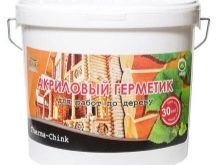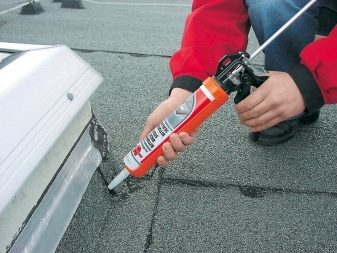Cold and waterproof sealants for outdoor applications
Building and repairing both inside the building and outside involves obtaining the perfect result, for which you almost always need to get rid of cracks or level joints. Different materials can be used, but not all of them can withstand frost and moisture, unlike modern sealants.
The choice of the appropriate type allows you to successfully carry out any operations on the street, while not worrying about the result due to the cold-resistant and waterproof qualities of the sealant.
Special features
Sealant, which is used to perform work outside the building, has a number of properties that allow it to retain its qualities in any weather. In their composition can be distinguished plasticizers, dyes, various additives.
All the elements included in the composition have technical characteristics allowing it:
- to be elastic, which is very convenient when filling seams and cracks;
- very durable, which makes it possible to work in difficult conditions with an intensively used object;
- not be afraid of a sharp jump in temperature;
- have a high degree of adhesion;
- have frost-resistant characteristics.
The advantage of silicone sealant can be considered versatility in cooperation with other materials: brick, cement, granite, and so on. Since there are many options for working outdoors, there may be several varieties of this building mixture. Polyurethane sealant is considered the most versatile and convenient.
Polyurethane-based adhesive / adhesive has the following advantages:
- high elasticity;
- good adhesion, which is important when the outer layer of the structure is processed;
- excellent water resistance - contact with water leads the sealant to an even stronger and more durable condition;
- short time solidification mass;
- resistance to ultraviolet radiation;
- it lacks toxins and other substances harmful to humans;
- serves for many years without losing its properties.
A special feature of frost-resistant sealants is the fact that they can be painted, while the surface is smooth and attractive. You can choose a color composition for work or completely transparent, depending on which surface the work will be performed.
Kinds
With the advent of sealants, it has become much easier to patch up bumps and cracks in different places, because every year the number of varieties of this building material grows, getting new properties and directions.
Today, species diversity can be classified as follows:
- Single component formulations. Most often they are packaged in tubes or foil packs. Harden may well with a thickness of application of both 2 and 12 mm. The scope of use - a variety of minor repairs and construction.
- Two-component formulations. Can become hard at any thickness of application.
The scope of their application is industry.
If we consider the sealant with respect to the scope of application, we can distinguish such types as:
- for metal - most often used when working with machines and drainpipes;
- for sealing joints and cracks - help protect the joint and at the same time serve as a heat insulator;
- for wooden objects - most often these are window frames, regardless of the type of wood;
- for construction - it can be used on any construction site;
- universal - it can be used in any of these cases.
In addition, you should pay attention to the color variety of sealants:
- The white version is most often used in plumbing, but you can successfully use it on metal-plastic windows, it also shows itself well in sealing the channels for the cable.
- Transparent is most often used in the case of sealing a wooden window with the opening itself. Due to the absence of color it will not be visible.
- Black sealant is used where exposure to ultraviolet light is high. Well manifests itself on the facade and roof, additionally can be used in the process of car repairs.
- The brown version is most often applied to surfaces that have the same color or shade.
- The color variants can be used in the same place as the white appearance, but you can also choose a tone or shade to minimize the selection of it from the environment.
If we consider the characteristics of the sealant, then it can be divided into such types as:
- Cold resistant. It is used during the work on sealing joints and stitching seams, when the outside temperature is negative, including very low air temperature.
- Water resistant. Used in cases where the room or work area is exposed to a strong level of humidity, which is most often found in the kitchen and bathroom inside the house or outside it.
- Heat resistant. Can be used when the air temperature becomes high or very high. This sealant can be applied to the stove, inside the house it is suitable for the heating system.
- Rubber - well suited for any repair and construction work. It is a moisture resistant sealant, so it can be used as an outdoor building compound for roofs, facades and similar surfaces that are exposed to moisture. It also shows excellent quality in interior decoration with high humidity: shower, toilet, kitchen.
Thus, sealant has become an indispensable tool for a wide variety of construction and repair work.
Due to the fact that it resembles rubber glue, it is possible to use it on different surfaces and not be afraid of the influence of moisture, sunlight or frost, which often causes the destruction of other finishing materials.
Scope of application
Cold-resistant and waterproof sealants are used in the winter season, because other options will not cope with the climate. In construction, this material is used to seal the joints of the roof, especially if it is made of modern materials, because they need additional protection along the joint line. Facade sealant will help to hide any defects on the front side of the building, and the possibility of painting this material makes it invisible, which is very convenient.
For prefabricated houses, cracks that cause drafts, especially noticeable in winter, are a very frequent problem. With only one sealant, you can get rid of this situation, but only if the gaps are small. In addition to the top of the building, it is worth paying attention to the bottom, because the whole foundation is a guarantee of the building’s durability and its reliability. The sealant, due to its universal qualities, is able to stop the cracking of the base and strengthen it for many years.
Outside, both new and old buildings, there are always some flaws that need to be dealt with in the early stages, while the destruction is minimal and can be dealt with using simple means.With the help of a universal silicone sealant, it is possible to connect parts of concrete and metal, fill voids and correct what initially failed or deteriorated over time.
It is especially easy and effective to use sealant during installation or repair of windows. Inside it is important to trim everything so that no trace of the substance is visible, but at the same time that all the gaps are securely closed. Outside, you can pay more attention to the protection of the window opening, filling all the gaps with sealant. By choosing a transparent option, you can achieve that it will be difficult to find the places where the work was carried out on the facade, and the use of color options will help to mask the area where the repair was carried out.
The use of sealant is large and it is difficult to imagine the repair of any premises, both inside and outside without the use of this mortar.
Thanks to the varieties that were invented, you can easily find the desired option and not doubt its effectiveness.
What temperature can withstand?
Construction work is most often not conducted in the winter, but there are always exceptions.There are situations of an emergency nature, when you have to repair the house outside in any weather, solving a sudden problem. In this situation, the temperature outside the window can be very different, which depends on the region, because it is important to properly use building materials and mixtures.
To work in negative temperatures, you need to purchase a cold-resistant version of the sealantwhich does not lose its properties even at -60 degrees. Low and extra low temperatures can affect the quality of work. That is why the use of a suitable sealant will help to cope with the situation quickly and get a good and high-quality result, which will not collapse by the next season.
If we talk about high temperatures that can withstand heat-sealing, then the maximum is +200 degrees Celsius, which can occur when working with heating facilities or appliances. In addition to the choice of heat-resistant composition, it is worth taking care of the protection of the body from exposure to high temperatures.
Any time of year dictates its own characteristics and it is important to know them and take them into account, then there will be no problems with repairs or construction.Waterproof, heat-resistant and frost-resistant versions of sealants will be able to cope with rainy weather, heat or high temperatures and sub-zero temperatures, while ensuring proper results when working with seams, joints and cracks anywhere on the facade.
It is necessary to focus on the temperature of the surface on which the work will be carried out. It is best that it is within the range of +4 to +30 degrees, while the ambient temperature can be from -40 to +120 degrees. Knowing the surface temperature is important in order to be able to calculate the time for the complete drying of the sealant, after which it can be painted and completed the repair. If the average layer thickness is 10 mm, then the temperature of the surface on which the composition was applied should be at least +25. The optimal indicators of the drying time of the composition will be one day.
If the surface has not been prepared, the adhesion will be worse and the silicone will dry much longer. When preparing the surface for work, it is important to clean it of dirt and dust and dry it, otherwise the result will be much worse.
The properties of the sealant remain after fifteen cycles of freezing and thawing at a temperature of -15 degrees, which indicates the durability of the building material and its resistance to the vagaries of the weather.
Tips
In order to get high-quality frost-resistant and moisture-resistant sealant and use it correctly, you need to know certain nuances:
- Buying a tube with the composition, it is worth examining it and checking the expiration dates, because even high-quality material will not be so effective after the end of its service life.
- When choosing a tube with a sealant, it is important to study it well for mechanical damage, because this will negatively affect the contents, and you should not expect a good result from using such a tool.
- It is important to choose the right silicone for a particular type of work. Cold-resistant take for the facade, which will be exposed to cold, but do not use near the furnaces, and vice versa.
- Choosing a sealant from a number of similar ones, you should give preference to a proven product and a well-known brand. The price for it is often a little higher, but you can be completely confident in the quality of the product.
- When planning a campaign for building materials, it is better to choose a building supermarket than the market, because the store has special conditions for storing any goods, everything has certificates and a guarantee that it can hardly be seen from a market trader.
If the repair with the use of sealant to be the first time, it is necessary to take care of the presence of the necessary amount of, calculating the consumption per m2, which significantly speeds up the process. It is necessary to conduct sealing of any areas slowly and having full confidence in what needs to be done. If there is no experience with the use of silicone, it is worthwhile to read about the intricacies of using it and see the visual video tutorials, then repairing any defects inside and outside the room will not be a problem, whether it be interior walls or finishing the passage between them.
It is possible to use frost-resistant and water-resistant versions of the sealant indoors, but often the scope of use refers specifically to facades, roofs and the foundation, which are subject to negative impacts. Construction and repair have become much easier with the advent of such mixtures, which even a non-professional can use.
How to choose a quality sealant, see the next video.





























































